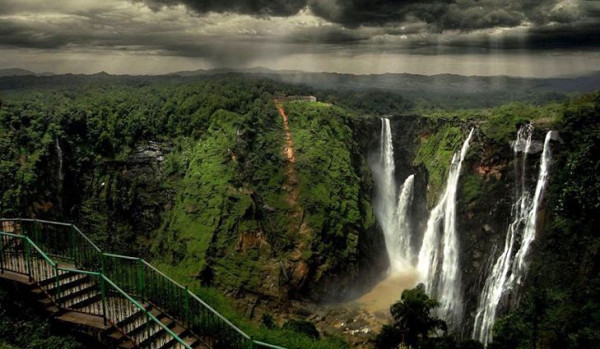Ecological Importance of Western Ghats
The mountain chain of Western Ghats is the source of all the major rivers of India’s southern peninsula; Godavari, Krishna, Tungbhadra, Kaveri, Tamraparni, and myriads of smaller one, Vaitarana, Kali, Netravati, Chazhiyar. Its ecological health depends on the livelihoods of millions of people, not only in the six Western Ghats states of Gujarat, Maharashtra, Goa, Karnataka, Tamilnadu and Kerala, but of Andhra Pradesh as well. Besides, it is one of the world’s treasure troves of plant and animal life, with a great wealth of unique plant and animal species. The mountains also harbour a number of wild relatives of cultivated plants, including pepper, cardamom, mango, jackfruit and plantain.
The health of this precious eco-region has been on continual decline over the last couple of centuries with many ecosystem types almost totally eliminated. Recent decades have however seen serious measures being initiated to conserve some of this fast vanishing biological diversity with the constitution of wild life sanctuaries, national parks, tiger reserves, and biosphere reserves. After that a significant new initiative has been added to these conservation efforts in the form of Ecologically Sensitive Areas(ESAs), such as Dahanu taluka, Matheran and Mahabaleshwar-Panchagani.
The concept of Ecologically Sensitive Areas is very different from that a protected area like a national park which is supposed to be entirely free from human interference, though in reality many management interventions such as creation of water holes and tourism related activities do continue even in the national parks. ‘Ecologically Sensitive Areas’ are areas under human use, sometimes quite intense human use such as generation of thermal power and cultivation of Sapodilla in Dahanu taluka. Hence, ESAs are to be viewed as areas where human activities will continue, but be prudently regulated under the Environment (Protection) Act, 1986. ESAs are not at all meant to stop development in ways that would hurt local people, but to ensure that development is environment friendly and people oriented, as well as serve to preserve the ecological heritage on a long term basis. There are no set regulations, such as ban on all new industries, or on conversion of agricultural into commercial land, that would prevail in every Ecologically Sensitive Area; instead, the regulations will be worked out with due respect to local context.
Thus, the total ban on use of plastics at Ooty could be thought of as a specific regulation appropriate for a busy hill station like Ooty although Ooty has not been declared an Ecologically Sensitive Area. More importantly, Ecologically Sensitive Areas are not just about regulation, but about positive promotion of environment-friendly development as well. Thus areas that opt for the status of an Ecologically Sensitive Area could benefit from special programmes such as promotion of development of enterprises based on local plant resources; whose fruit has been traditionally used in very many ways, and is now known to be an important source of hydroxycitric acid, or establishment of a green technology team of youth trained in setting up and maintaining solar panels, biogas plants, rain water harvesting devices, and so on. Gram Panchayats in Ecologically Sensitive Areas could also receive special facilities to add to their incomes through taking advantage of new legal provisions such as charging collection fee for biodiversity resources to which they are entitled under the Biological Diversity Act. They may also be paid specially for maintenance of traditional crop cultivars from the National Gene Fund, or for sequestration of soil carbon on farmlands under organic agriculture as a part of Indian plans for combating climate change.
Some Facts about Western Ghats
- It runs, about 1600 km., North to South, along the western edge of the Deccan Plateau.
- It is one of the eight hottest hotspots of biological diversity in the world.
- It originates near the border of Gujarat and Maharashtra, and runs through the states of Maharashtra, Goa, Karnataka, Tamil Nadu and Kerala, finally ending at Kanyakumari.
- These hills cover a total area of 160,000 square km.
- The average elevation is about 1,200 m (3,900 ft).
- The region is home to over 5000 species of flowering plants, 139 mammal species, 508 bird species and 179 amphibian species.
- The Western Ghats is home to at least 84 amphibian species, 16 bird species, 7 mammals, and 1,600 flowering plants which are not found elsewhere in the world.
- There are numerous protected areas designated by the Government of India in the Western Ghats. They include 3 bio reserves and 13 National Parks.
- The Nilgiri Biosphere Reserve that comprises 5500 square km. of evergreen and deciduous forests forms an important part of the Western Ghats.
- The Silent Valley National Park in Kerala, which forms part of the Western Ghats, is one among the last tracts of virgin tropical evergreen forest in India.
- In 2012, 39 places in the Western Ghats region have been declared as World Heritage Sites by the UNESCO.
Scientists view an ecologically sensitive area as an area whose ecological balance, once disturbed, is very hard to restore. Thus, steep western slopes of Western Ghats, subject to heavy rains and winds, if deforested, are likely to be quickly stripped of soil cover and for ever lose their pristine vegetation. A Western Ghats Ecology Expert Panel, constituted by the Ministry of Environment and Forests, Government of India was engaged in carefully compiling all available information in this context and preparing maps of levels of ecological sensitivity on the Western Ghats tract.
Ecological sensitivity is not merely a scientific, but very much a human concern. In particular, a great deal of locality specific understanding of what has been happening and what is desirable is simply not part of any scientific databases and resides with local communities. It is important that concerned people share their own perceptions as to what areas on the Western Ghats should be identified as being ‘Ecologically Sensitive Areas’, why they feel so, and what set of regulations tailored to the needs of the locality should be put in place if the area were to be formally declared as being ecologically sensitive.
Courtesy : bit.ly/2js5RkW




